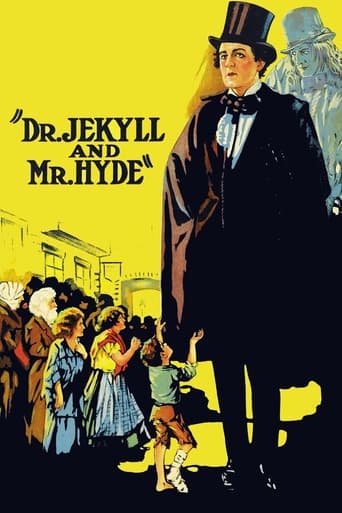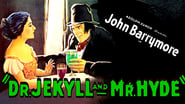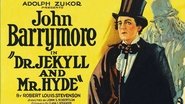ElMaruecan82
The "Dr. Jekyll and Mr. Hyde" DVD I took from the library featured both the 1931 and 1941 version. To be honest, after finishing the two films, I didn't feel the need to watch any other version. Not that I thought the 1941 version broke any particular ground, but I said in my review that it was enhanced by the performance of Ingrid Bergman while undermined by the Hays Code. It was good but the 1931 version was the definite one as far as I was concerned.But I'm a movie trivia buff and checking on the list of memorable screen-characters nominated for the American Film Institute's Top 100 Heroes and Villains, I saw that both Dr. Jekyll and Mr. Hyde were nominated. But it was Fredric March' Hyde vs. John Barrymore's Jekyll, so there had to be something pretty heroic about Jekyll to deserve that spot and I wanted to make up my own mind. And given how slightly disappointed I was by the 1941 film, I thought maybe the 1920 version explored some realms omitted by the 1931, maybe that the rise of the talkies didn't permit or made obsolete. I knew I could easily find it on Youtube, so I watched it and I'm glad I did. It is perhaps one of the earliest classics of the horror genre (two years before "Nosferatu") and while made by a rather unknown director named Robertson but it features a very recognizable face from Golden Age buffs: John Barrymore, who's probably to American movies what Jean Marais was to French Cinema. By that I mean he probably possesses one of the best-looking male profiles I saw recently, of course, he's more than a pretty face. John Barrymore embodies through his performance as Jekyll the torment of a good man, Jekyll is a figure supposed to represent the uptight Victorian man, but it's not as a symbol as we feel sorry for him.In an era where men were supposed to hide their feelings and impulses, and maintain their facade of respectability while indulging to the darker calls of human soul, Jekyll is an abnormally decent man. He's presented as a 'philanthropist' by nature, because he's a doctor in medicine, but it's not just about his chosen professional path. This is a man who's innately good, who maintains an old repair shop at his own expenses to treat the poor people. He's a good man and not even devoured by ambition, one would think Mr. Carew already had the perfect son-in-law but the man couldn't believe a man was so good as he looked, his cynicism set up the story... and backfired at him.So it's during a banal dinner conversation that the father-in-law raises the idea of the battling between good and bad self, the metaphor used is left or right hand, just because he doesn't use one for writing or eating, doesn't mean he can't ever use it. The man also encourages the young chap to live his young age, and stop dedicating him time to the others, he quotes Oscar Wilde: "the best way to resist a temptation is yield to it". This plants in Jekyll's mind the idea of separating the two parts of the human soul, letting a man fulfill his worst desires while leaving the soul untouched. Quite fascinating to have a Jekyll about someone being ashamed from being 'too good'.But the merit of this "good" Jekyll is that he's about to become a real contrasting personality to his Mr. Hyde alter ego. Edward Hyde is basically as hideous and menacing as Jekyll looked good and romantic, and Hyde's face keeps on going more and more bestial looking until the final scene where he's a real monster of a man. The duplicity is powerfully suggested and makes the figure of Jekyll a real tragic one. In both the 1931 and 1941 version, the tragic figure was Ivy Pearson, the 'bad company' woman, but this one gives more latitude and substance to the figure of Jekyll, maybe to show that a man can be victim of his impulses or victims of his own attempts to resist them.The film's power totally lies on John Barrymore's performance and the other characters are eye candy but only valuable players at his periphery, Nina Naldi (said to be the female Valentino) plays the woman of exotic charm and Martha Mansfield (who died tragically as a freak accident) is the obligatory female woman but the real arc belongs to Barrymore. It is also worth noticing that, being a silent film, the film provides more ominous sights of Victorian London, perhaps because they didn't need to "stage" it in 1920 and the texts are more impacting than all the speeches from the other films. Again like many old silent movies, the looks or sounds depend on the versions, I watched one without the sepia tones and with the organ music, but I don't think they were integral to the film's enjoyment. I still consider the 1931 one to be the best, but this one comes closer.
roddekker
*Please note* - This version of Dr. Jekyll and Mr. Hyde is, in fact, a silent-era picture. It is now nearly 100 years old. If you choose to judge this picture by today's "in-your-face" standards of total over-the-top horror & gore, then, to be sure, you are going to be mighty disappointed with what you see here.But if you have an appreciation for film history, and can value this film's story in its understated form, and can forgive it for all of its obvious flaws and faults, then, yes, this old relic will definitely be worth your while to watch.From my point of view - I was actually quite impressed with the creepy, eerie and sinister atmosphere that prevailed in this production. Now, I would certainly never say that this was a great film. But, with that aside - I'll bet you that, upon its initial release, back in 1920, it must have scared the socks off of many of the viewers in the audience.
Robin Blake
I won't say much about the story itself, as many of you should already know it. That is unless you you haven't read this great Robert Louis Stevenson story, and to that I say get thee to a library and check it out. Or you could probably read it online. I don't know.Anyway, this 1920 silent film adaptation stars John Barrymore as the titular characters. The movie itself was great. The acting and costumes were fine, and the Jekyll/Hyde transformations were really cool. The Mr. Hyde makeup was very well done. Hyde looked disheveled, creepy and positively evil. Also looked like he hadn't bathed in weeks. That's a stark contrast to the clean, neat, upstanding Dr. Jekyll.My only pick is the score on this version could have been better. Sometimes the music didn't match the film. Kinda odd for some happy upbeat sounding music playing over a rather dismal scene. But the version I watched was on this "50 Horror Classics" DVD set which only cost me $9, so I guess I can't complain too much. Still a great film regardless.
DLewis
It is sometimes said that Paramount's 1920 production of "Dr. Jekyll and Mr. Hyde" is the first American horror film. It seems hard to qualify that now, given the existence of the Edison Company's "Frankenstein" and at least two among three earlier, short film adaptations of Stevenson's story. Nevertheless, Paramount's "Dr. Jekyll and Mr. Hyde" may still be the earliest American horror feature, and certainly is the earliest one that we can still see. And yet it is not fully an artifact, as it still packs some measure of thrills and horrific punch, largely due to the bravura performance of its star, John Barrymore, then primarily known as a popular stage actor despite a small number of forgotten movies he'd already appeared in, all but one being lost today. Helmed by stage veteran John S. Robertson -- who would go on to a long career as a Hollywood film director and also co-wrote the stage play of "Dracula" that brought Bela Lugosi to prominence -- this adaptation of "Dr. Jekyll and Mr. Hyde" was largely based on Thomas Russell Sullivan's 1887 stage play, which adds a love interest and eliminates the character of Utterson in Stevenson's novella. Barrymore would have been very familiar with the play, and with the actor who most famously toured in it, Richard Mansfield. Interestingly, Sheldon Lewis, who starred in the indie quickie knockoff of Barrymore's "Dr. Jekyll and Mr. Hyde" also appearing in 1920, also used Mansfield's performance as a reference, but emphasized different aspects of it from Barrymore. Though he had already directed several films, Robertson's direction here is uneven, ranging from something slightly more ambitious than just filming the stage play up to fairly lively cinematic action, though a fair amount of this is in the choppy second third. There are at least two versions of this film on the market, and content can be quite variable in terms of both run times and shots used. In the second third continuity is hard to follow; it is better than in the final third, but there is still some material missing. Overall, it still plays fine, though it helps to know the story. Nita Naldi -- in her film debut -- is earthy and sensuous, and the film also offers a rare glimpse of the ill-fated Martha Mansfield, though as the long-suffering bride-to-be perpetually unable to figure out just what is going on, Mansfield has an unenviable role. It's Barrymore who steals the show -- while some comment that his acting is too melodramatic and over the top, by the standards of Victorian theater it is exactly what it is supposed to be and more. Some sources state that Barrymore didn't use makeup to appear as Hyde, and this is incorrect -- there is makeup on both his face and hands, but for it to work, and to terrify, it is up to Barrymore. He does so spectacularly, even though the nature of the makeup job tends to change, making Barrymore in some scenes merely like a creepy creepster and in others a more genuine monster, an effect some suggest was intentional. More than a hundred film versions of "Dr. Jekyll and Mr. Hyde" have been made since this one in 1920, and despite its silence and great antiquity, is still the favorite adaptation of this property for many viewers, owing to its totally authentic Victorian atmosphere and the sheer power of the lead portrayal. The trivia isn't right; the Astoria studio was still under construction when this went into production and it was shot upstairs at the Amsterdam Opera House on West 44th St. in Manhattan, at odd hours, as Barrymore was playing one role on the stage and rehearsing another at the time. One of the first American features shot entirely indoors with artificial light, the film benefits from the rather cramped and claustrophobic settings, not to mention well chosen set decor.






